Yew Trees: Types, Berries, Leaves (Pictures) – Identification
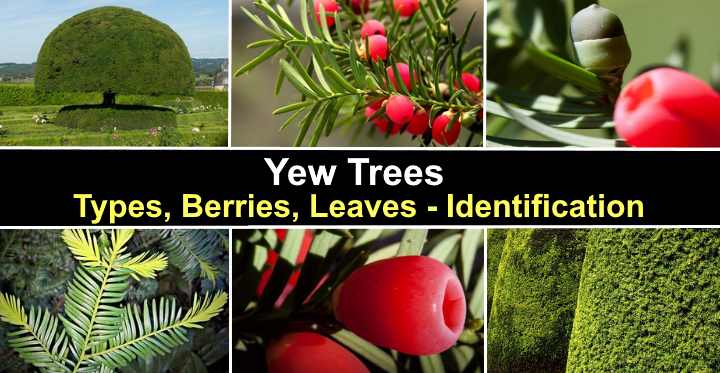
Yew trees are a group of coniferous trees with dark-green linear needle-like leaves, small red berry-like fruits, and small inconspicuous flowers. Yews are typically medium-sized evergreen trees. Yews are identified by their thin, scaly brown bark, tiny single-seed cones, red fruits, and linear flat leaves. The English yew (Taxus baccata) is the most common species. But Irish yew, Western yew, and Japanese yew are also ornamental conifer trees.
The Western yew or Pacific yew (Taxus brevifolia) is a species native to North America. The American yew is common on the west coast and grows in coniferous forests from Alaska to California. In addition to tall yew trees, yew shrubs are popular landscaping plants for gardens.
This article is a comprehensive guide to identifying the most common types of yew trees. Descriptions and pictures of yew tree leaves, berries, flowers, and bark will help with yew tree identification.
Yew Tree Facts
Yew (botanical name Taxus) is a genus of slow-growing coniferous evergreen trees and shrubs. However, yews are typically long-lived trees that can live for hundreds or even thousands of years. Ornamental yew trees grow between 35 and 65 ft. (10 – 20 m) tall and up to 20 ft. (6 m) wide.
Yews are cold-hardy evergreen trees that thrive in USDA zones 3 to 7. Yews can grow in temperatures as low as -13°F (-25°C); however, the shade-loving trees don’t perform well in prolonged hot temperatures.
Yew trees have branches with dense evergreen foliage. Compared to pine trees, yews have low-lying branches that may touch the ground. Overall, yews have a pyramidal crown with branches that tend to point upward at the end.
If you want to plant a yew tree as a tall hedging plant, it is best to choose a shaded spot because the evergreen trees grow well in partial sun or deep shade. Ensure that the ground is well-draining and protect yew trees from heat, drought, and full sun for more than six hours a day.
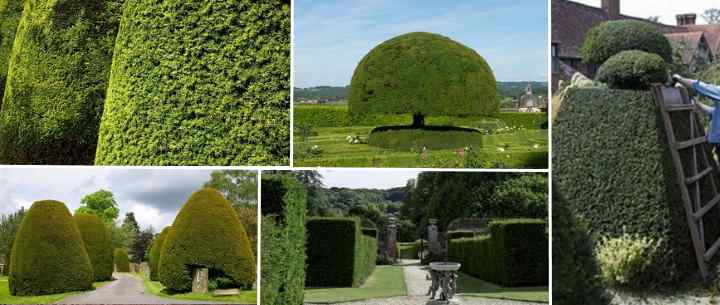
Yew trees, which have dense evergreen foliage, love pruning and are a great as privacy hedge or topiary
Most parts of yews shrubs and trees—the leaves, bark, and seeds—contain dangerous poisons. The only part of a yew plant that is edible is the sweet red berry-like fruit called an aril. This cup-shaped fruit can be eaten raw; however, it’s vital to spit the seed out. Scientists say that 50 g of yew needles is enough to kill an adult.
Yew Tree Leaves
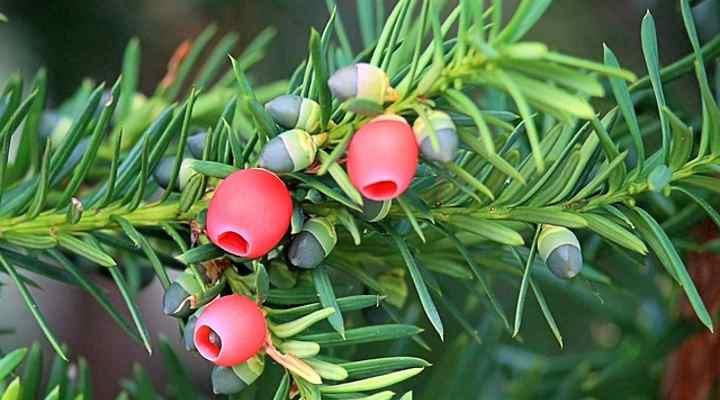
Yew needle-like leaves and mature and immature fruit
Yew trees are identified by their long, narrow, flat, lanceolate, needle-like leaves with rounded tips. Yew leaves measure between 0.4” and 1.5” (1 – 4 cm) long and 0.1” (3 mm) wide. A characteristic feature of yew leaves is their arrangement in two rows along stems and spirally on upright stems.
On most species of yew trees, the flat linear leaves are a dark green color. However, on some yew trees, the leaves have bluish-green undersides, giving the tree a shimmering effect in the breeze. You can also spot yew leaves by the raised central vein on the leaf underside.
Comparing the leaves of yews to other coniferous trees makes it easy to recognize yew conifers. Compared to pine needles and larch tree leaves, yews have flatter leaves and don’t grow in bunches. Yew leaves grow along stems like spruce trees, but they are much broader. Yew leaves look nothing like cypress and arborvitae foliage of feathery sprays.
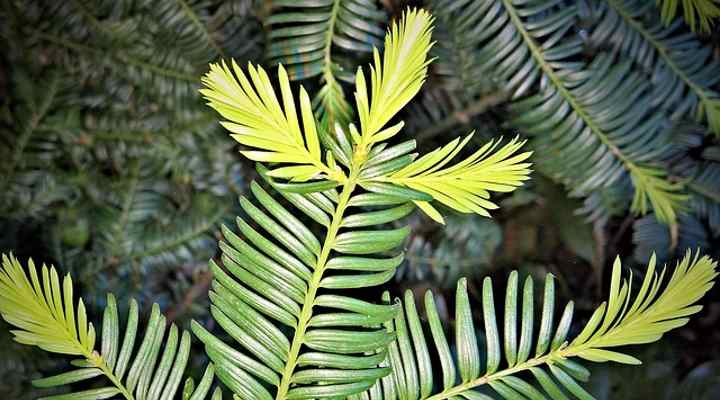
Yew leaves are flatter and broader compared to other coniferous trees
Yew Berries

Yews berry-like red fruits (arils) are edible but the seed is poisonous
An identifiable feature of yew trees is the red berry-like fruits called arils. These cup-shaped fruits contain a single poisonous seed. The fleshy-red aril is the only part of the yew plant that is edible. Unlike most species of conifers with seed-bearing cones, yew fruit and seeds grow directly on the stems, not in cones.
The red berry-like fall fruits and lack of cones are the easiest way to identify yews in landscapes.
Yew Flower
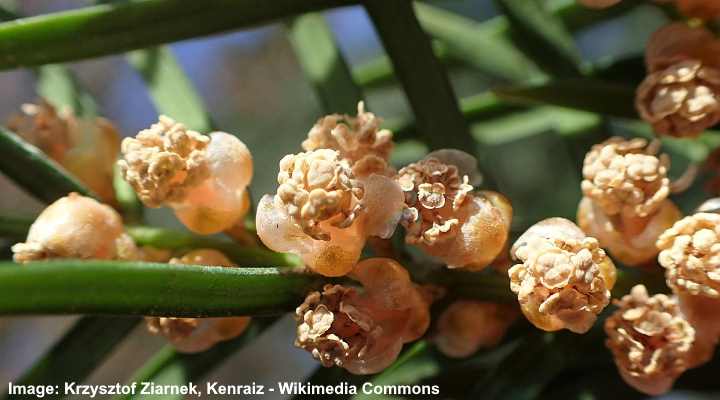
Female flowers (pollen cones) of English yew
Yew tree flowers bloom in early spring and are insignificant creamy-white globe-like clusters. Yews are dioecious plants with male and female flowers growing on separate trees. Female yew flowers develop into small, scaly bud-like structures resembling an acorn. They then develop into red fruits. Male yew flowers turn into woody cones that look like tiny Brussels sprouts.
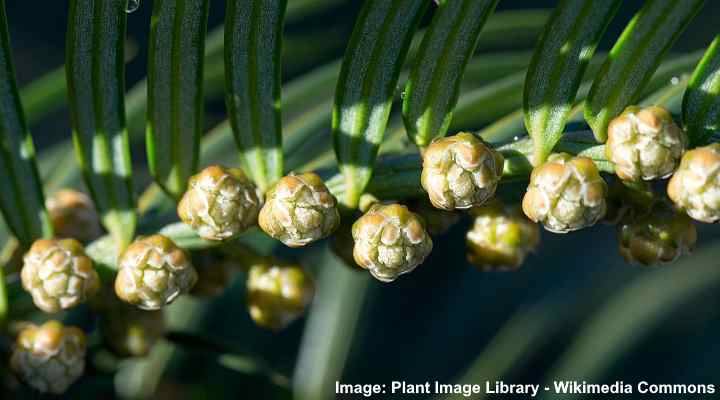
English yew male flowers
Yew Tree Bark
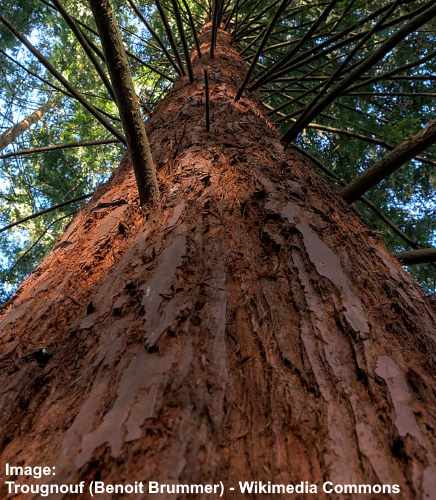
Bark of English yew (Taxus baccata)
Yew tree bark is identified by its reddish-brown and distinctive appearance. Immature yews have identifiable smooth bark with mottled brown and gray shades. As yew trees mature, the bark develops deep vertical ridges and furrows. Pictures of yew bark show scaly bark that sometimes flakes off to reveal red patches.
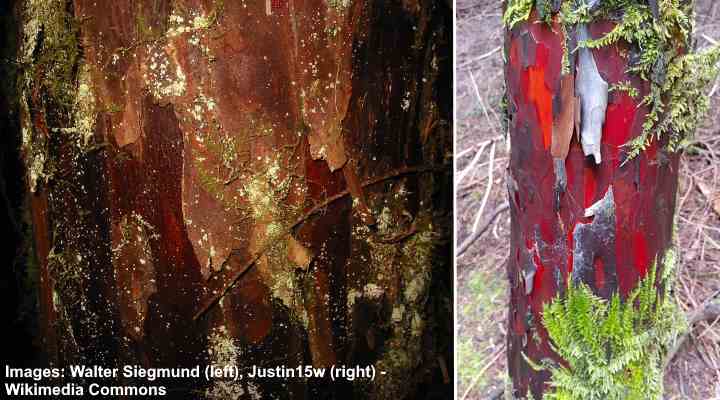
Bark of Pacific Yew / Western Yew (Taxus brevifolia)
Yew Identification
The easiest way to identify a yew tree is by its red berry-like arils and long, flat, dark green needle-like leaves. Yew identification in winter is by its evergreen foliage and lack of seed-bearing ovoid or conical cones. Other identifiable characteristics of yew trees are scaly bark, and clusters of small bud-like spring flowers.
Types of Yew Tree (With Pictures)
Here are some of the most common types of yew trees with their pictures and identification guide.
Common Yew / English Yew (Taxus baccata)
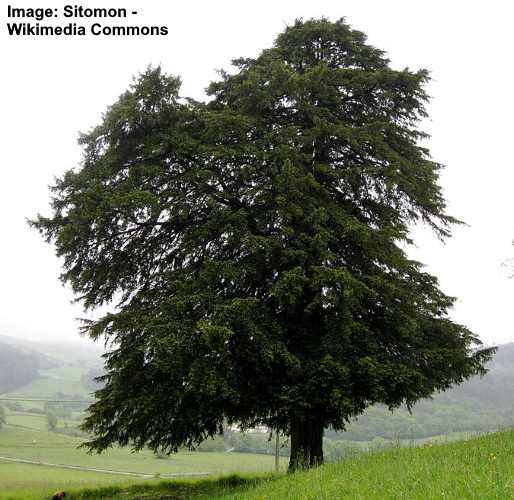
Common Yew / English Yew (Taxus baccata) tree
The English Yew or Common Yew is a medium-sized tree with flat needle leaves and red fruits growing around a single seed. The common yew grows between 30 and 60 ft. (9 – 18 m) tall and 15 to 25 ft. (4.5 – 7.6 m) wide.
You can identify the English yew among conifers due to its pyramidal crown. However, as the slow-growing conifer matures, its form becomes more irregular.
Common yew fruits are small fleshy, cup-shaped structures with a seed in the center. The red or burgundy berry-like arils measure up to 1” (2.5 cm) and appear on the tree in the fall. The flesh of the red yew fruits is the only part of the tree that isn’t poisonous. The berry-like fruits have a sweet taste.
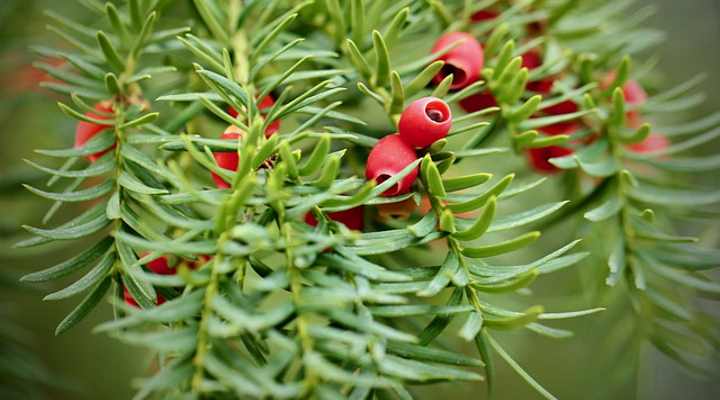
English yew leaves and fruit
Common yew trees have a thin, scaly, reddish bark covering a thick trunk. As the yew tree matures, the smooth mottled bark develops fissures and has a flaky appearance.
The English yew thrives in USDA zones 6 through 9 and thrives in partial to full shade. Compared to other yew species, the Taxus baccata tolerates summer heat and humidity better.
The best way to grow common yews in a garden landscape is as a shade tree, evergreen hedge, and—with proper pruning—a foundation planting.
The common yew had the botanical name Taxus baccata. The Latin name baccata refers to the fleshy red arils. However, botanists now give the common yew the scientific name Cephalotaxus harringtonia. Other common names for the yew include Anglo-Japanese yew, Japanese plum yew, and spreading plum yew.
Common yew cultivars have varying shapes and sizes, and many are suitable for small, compact gardens or container growing. Here are a few varieties of English yews:
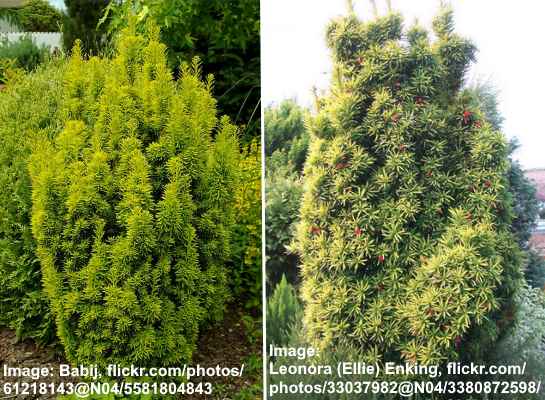
Small cultivars of English yew include Taxus baccata ‘David’ (left) and Taxus baccata ‘Standishii’ (right)
- Common yew ‘David’ (Taxus baccata ‘David’)—This columnar evergreen small tree has erect branches with green and gold leaves arranged spirally. It matures at 8 to 10 ft. (2.4 – 3 m).
- Common yew ‘Dovastoniana’ (Taxus baccata ‘Dovastoniana’)—The small, spreading yew tree has dark green leaves growing on branches with pendulous tips. The fast-growing yew matures at 6 to 15 ft. (1.8 – 4.5 m) tall and up to 8 ft. (2.4 m) wide.
- Common yew ‘Standishii’ (Taxus baccata ‘Standishii’)—This cultivar is a columnar evergreen tree with golden-yellow needle leaves and coral-red fruits. The yew cultivar is perfect for containers or small gardens and grows 5 ft. (1.5 m) tall and 2 ft. (0.6 m) wide.
Yew Tree Leaves
English (common) yew tree leaves are flat thin dark green lanceolate leaves measuring 1.5” (3.8 cm) long and 0.1” (3 mm) wide. Common yew tree leaves have a flat base that twists to make the leaves appear as two rows along a stem. On upright stems, yew leaves grow in a recognizable spiral arrangement.
Yew Tree Identification
English yew tree identification is by its flat leaves, thin scaly brown bark, and fleshy red cup-shaped berries.
Irish Yew (Taxus baccata ‘Fastigiata’)
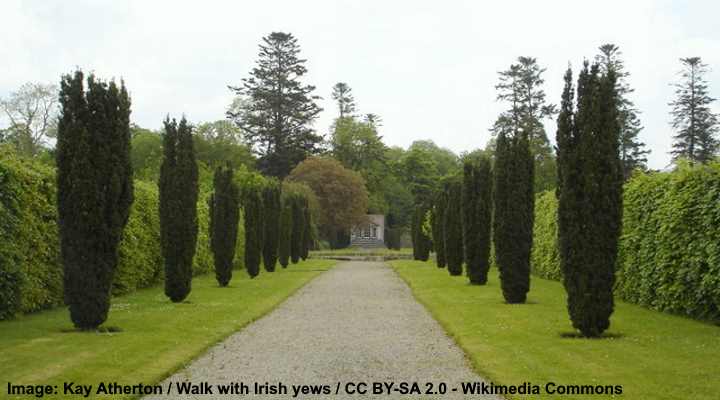
Irish yew (Taxus baccata ‘Fastigiata’) trees
The Irish yew is a columnar narrow coniferous tree with erect branches, dense needle-like foliage, and showy red round fruits. As a fast-growing conifer, the Irish yew tree grows at a rate of 12” (30 cm) per year, maturing at 4.5 to 10 ft. (1.5 – 3 m) tall and up to 3 ft. (1 m) wide.
The best way to identify an Irish yew tree is by its columnar shape, and stiff, erect branches with dark green needles arranged radially on stems. As the upright yew tree matures, its growth slows, and it develops a flat top.
Like all yew trees, all parts of the plant except the fleshy fruits are poisonous. The round coral-red berries appear in the fall and have an opening revealing the seed inside. The soft linear needle leaves grow densely on upright stems. Its bark is gray-brown; however, the yew’s bark is barely visible due to the low branching growth habit.
Irish yew trees thrive in USDA zones 6 to 8. Unlike other types of yew trees, the Irish yew ‘Fastigiata’ performs well in full sun. However, it also tolerates shade and is easy to grow in most garden landscapes—one of the reasons it’s the most popular conifer in the world.
Taxus baccata ‘Fastigiata’ is ideal planting as a hedging plant, living screen, evergreen privacy barrier, or foundation planting. It is also the perfect evergreen columnar tree to add a vertical accent in garden landscapes or plant at a shaded corner of the house.
The Irish yew Taxus baccata ‘Fastigiata Aurea’ has spectacular yellow to lime-green leaves. This columnar yew has the same growth habits as the ‘Fastigiata’—erect branches with soft, dense foliage and coral-red fleshy fruits.

Taxus baccata ‘Fastigiata Aurea’
Yew Tree Leaves
The Irish yew tree leaves are longer than English yew leaves. The dark green leaves are arranged spirally on stems, creating dense foliage.
Yew Tree Identification
The best way to identify an Irish yew tree is by its columnar, cigar-like shape. As with all yew conifers, the tree produces bright red berry-like fruits.
Pacific Yew / Western Yew (Taxus brevifolia)
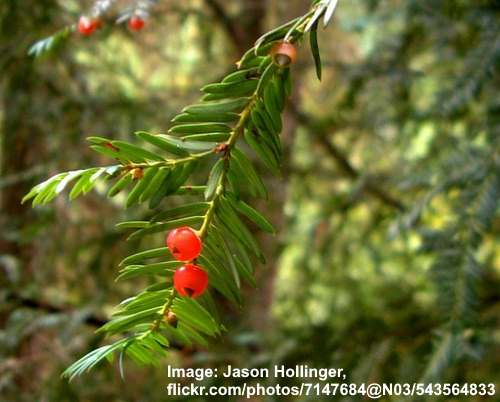
Pacific Yew / Western Yew (Taxus brevifolia) leaves and fruit
The Pacific yew is a medium-sized conifer with short needle-like leaves, soft bright red rounded fruits, and reddish-brown bark. Also called the Western yew, this needled evergreen has a dome-shaped crown. The Pacific yew is a slow-growing tree that matures at 33 to 50 ft. (10 – 15 m) tall.
Western yew trees are relatively cold-hardy trees and thrive in USDA zones 4 to 6. The ornamental plants are easy to grow and perform just as well in full sun as in full shade.
The characteristic features of Pacific yew trees are linear needles arranged radially on stems and scarlet oval fleshy fruits.
The scientific name of the Western yew – Taxus brevifolia – refers to its tiny leaves. Compared to other yews, the needles are somewhat shorter. But they still have the characteristic yew needle leaf shape—thin linear flattened needles with a rounded tip and point.
Yew Tree Leaves
Like all yews, the Pacific yew tree leaves are flat, lanceolate dark green needles arranged spirally on a stem. However, the twisted leaf base looks like the needle blades grow in two rows. The small leaves measure 0.4” – 1.1” (1 – 3 cm) long, making them some of the smallest leaves from species of yew trees.
Yew Tree Identification
Look for the soft green leaves growing in two flat rows, bright red fall “berries,” and thin, scaly brown bark to identify Pacific yew trees.
Japanese Yew (Taxus cuspidata)
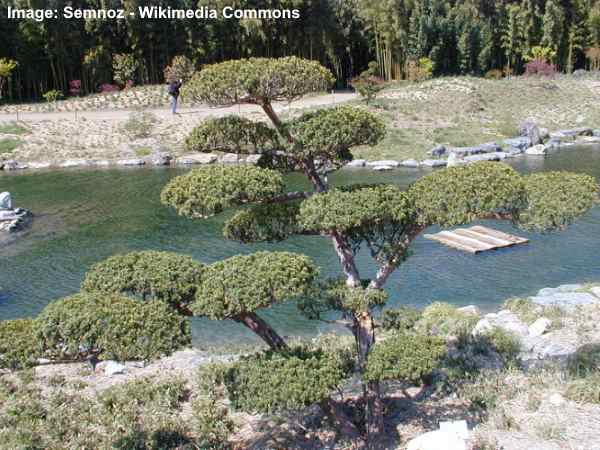
Cloud pruning of Japanese yew (Taxus cuspidata) tree
The Japanese yew tree is a large spreading ornamental shrub-like tree with flat needle leaves, fleshy red seeded fruits, and flaky brown bark. The Japanese yew is also called the spreading yew due to its wide spread. This yew tree grows 30 to 60 ft. (10 – 18 m) tall.
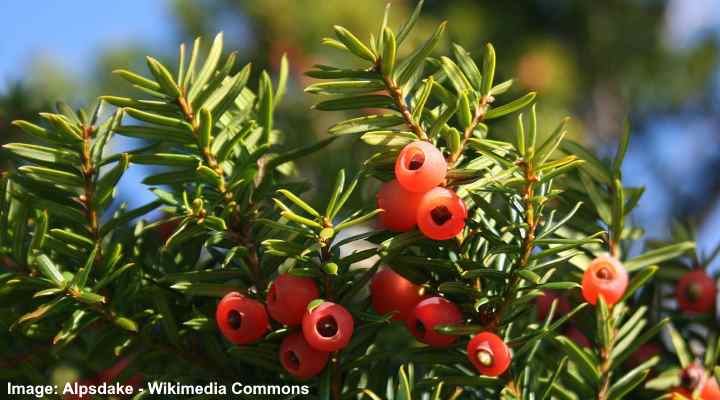
Japanese yew (Taxus cuspidata) leaves and fruit
The Japanese yew looks like the common yew or English yew. The difference of this yew species is that it’s hardier and faster-growing than the common English yew. Additionally, the flat needle-like lanceolate leaves have two distinct yellow bands on their underside.
In North America, the Japanese yew is typically planted as a dwarf cultivar or small spreading shrubs. You can plant a spreading, low-growing Japanese yew shrub that only grows 2 to 3 ft. (0.6 – 1 m) tall and up to 10 ft. (3 m) wide for ornamental gardens.
Some Japanese yew varieties to use as landscaping plants include:
- Taxus cuspidata ‘Aurescens’ (Golden Japanese Yew)—A small shrub with golden foliage, growing 1 ft. (0.3 m) tall and 3 ft. (1 m) wide.
- Taxus cuspidata ‘Capitata’—A tall pyramidal evergreen yew, growing up to 25 ft. (7.6 m) tall.
- Taxus cuspidata ‘Densa’—This dwarf shrub grows 4 ft. (1.2 m) tall and 8 ft. (2.4 m) wide.
Yew Tree Leaves
Japanese yew tree leaves are flat, narrow lance-shaped blades measuring 0.4” to 1.18” (1 – 3 cm) long and up to 0.1” (3 mm) broad. The tiny needles grow in two flattened rows along stems. But on erect stems, the needle leaves grow spirally.
Yew Tree Identification
Identify the Japanese yew tree by its broadly columnar shape, rounded growth, and spiny-tipped lanceolate needles. In the fall, you can recognize this evergreen tree by its bright red fall fruits.
Himalayan Yew (Taxus wallichiana)
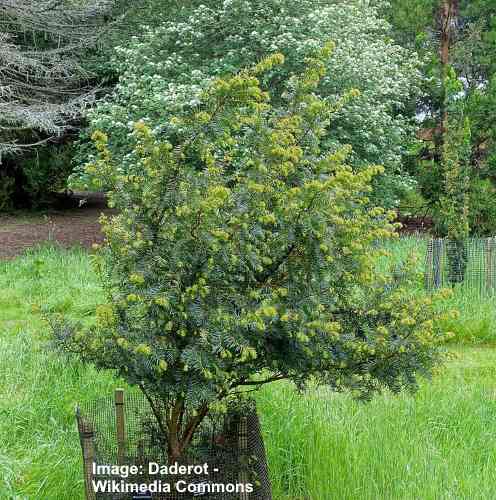
Himalayan Yew (Taxus wallichiana) young tree
The Himalayan yew is a medium-sized tree with a conical shape, spreading crown, dense foliage consisting of dark green lanceolate-shaped leaves, and red or orange oval fruits. Himalayan yews usually grow to 10 m (33 ft.) tall, but can reach up to 100 ft. (30 m) tall. Its bark is reddish-brown that peels off in strips revealing purplish patches.
The coniferous Himalayan yew tree is mostly poisonous—the seeds, leaves, and bark contain potent toxins. The only edible part of the yew tree is the sweet fleshy red aril that measures 0.4” (1 cm) in diameter.
Yew Tree Leaves
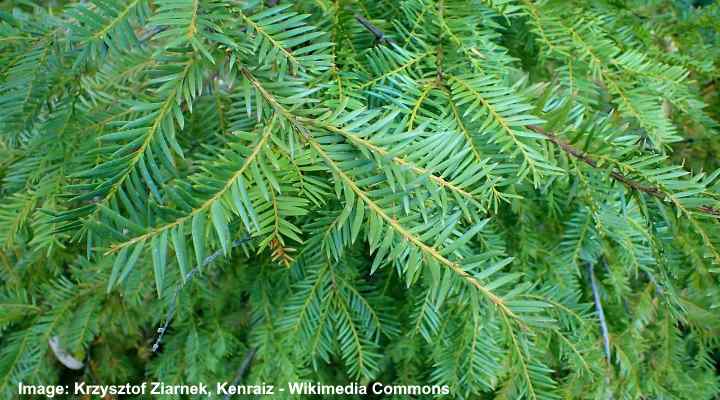
Himalayan yew leaves
Himalayan yew tree leaves measure 0.6” to 1.4” (1.5 – 3.5 cm) long and 1.5” (4 mm) wide. Like all yew trees, the dark green leaves are arranged radially on stems. But their twisted base makes them look as if they grow in flattened rows on either side of the stems.
Yew Tree Identification
Identify a Himalayan yew tree by its pyramidal or rounded crown with erect, spreading branches densely covered with dark green needle-like leaves. The evergreen foliage stays dark green throughout the year, and bright red berry-like fruits provide color during the fall.
Related articles:
- Types of Red Berries That Grow on Trees or Shrubs
- Dwarf Conifers: Dwarf Pine, Spruce, Cypress, Juniper & Yew
- Types of Yew Shrubs
